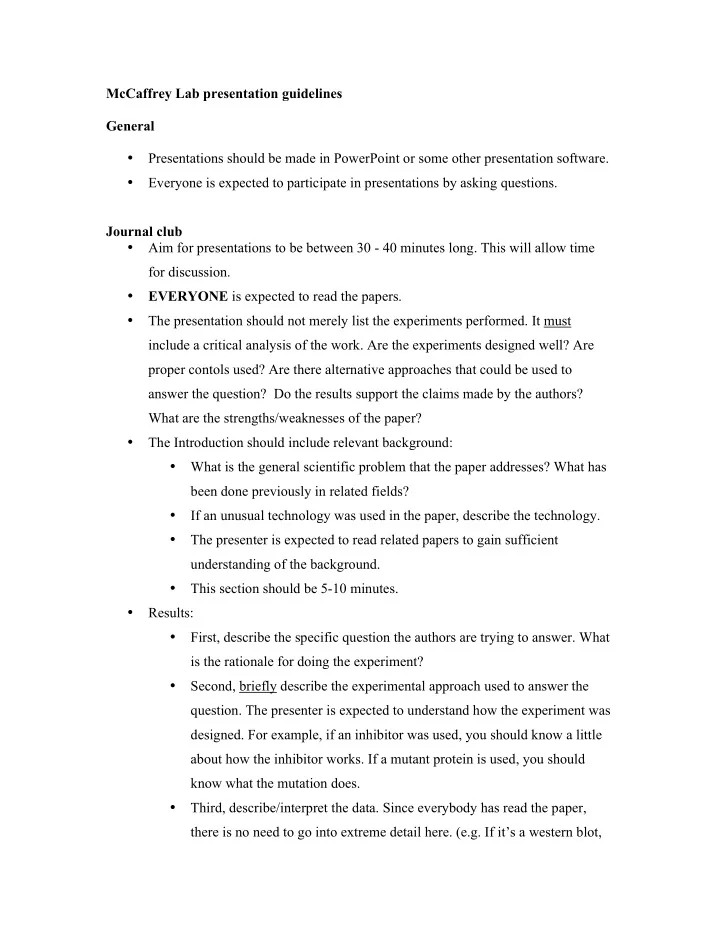

McCaffrey Lab presentation guidelines General • Presentations should be made in PowerPoint or some other presentation software. • Everyone is expected to participate in presentations by asking questions. Journal club • Aim for presentations to be between 30 - 40 minutes long. This will allow time for discussion. • EVERYONE is expected to read the papers. • The presentation should not merely list the experiments performed. It must include a critical analysis of the work. Are the experiments designed well? Are proper contols used? Are there alternative approaches that could be used to answer the question? Do the results support the claims made by the authors? What are the strengths/weaknesses of the paper? • The Introduction should include relevant background: • What is the general scientific problem that the paper addresses? What has been done previously in related fields? • If an unusual technology was used in the paper, describe the technology. • The presenter is expected to read related papers to gain sufficient understanding of the background. • This section should be 5-10 minutes. • Results: • First, describe the specific question the authors are trying to answer. What is the rationale for doing the experiment? • Second, briefly describe the experimental approach used to answer the question. The presenter is expected to understand how the experiment was designed. For example, if an inhibitor was used, you should know a little about how the inhibitor works. If a mutant protein is used, you should know what the mutation does. • Third, describe/interpret the data. Since everybody has read the paper, there is no need to go into extreme detail here. (e.g. If it’s a western blot,
don’t say things like “In lane 1 they loaded cells with inhibitor X. In lane 2 they loaded cells without inhibitor X. They blotted for protein Y with an antibody. In lane 1 you see band Y and in lane 2 you also see band Y, but it’s a little bigger than in lane 1”. Instead, say things like “To determine if protein Y is regulated by enzyme E, they treated cells with inhibitor X. The blot shows that there is less protein Y in inhibitor treated cells, demonstrating that enzyme E is required to stabilize protein Y.” • Forth, relate how the outcome of the experiment relates to the overall objective/hypothesis of the paper. • The supplementary data is often important; bring it into the presentation where appropriate. • Discussion/conclusion • Recap the major finding(s) of the paper with a clear model. • What are the strengths/weaknesses of the paper? • What additional questions are raised by the work? Suggest some follow- up work that could be done to answer these questions? Project presentations • Aim for a presentation that is 40-50 minutes long. Early on in the project this means you will have longer Introduction and Future Goals sections. As you get more data, the Results/Data section will expand. • Introduction: • What is the general scientific problem that you are trying to addresses? What has been done previously? • The background should be sufficient so that somebody not in our lab would understand the project. • Only include information that is central to understanding the results that you present later in the talk. • If you use images/figures from other papers, make sure to cite them. • Results/data
• First, describe the specific question you are trying to answer. What is the rationale for doing the experiment? • Second, briefly describe the experimental approach used to answer the question. • Third, describe what the data shows, and interpret the meaning for the audience. • Forth, relate how the outcome of the experiment relates to your overall project. • Don’t be afraid to indicate weaknesses in your own work. But make sure to indicate how you are going to address the weaknesses. • Conclusion • How does your work relate to the broad scientific question outlined in the introduction? • Future goals • Describe 2-3 specific follow-up experiments you are planning that are related to the project goals. • Show some preliminary data if you have it.
Recommend
More recommend